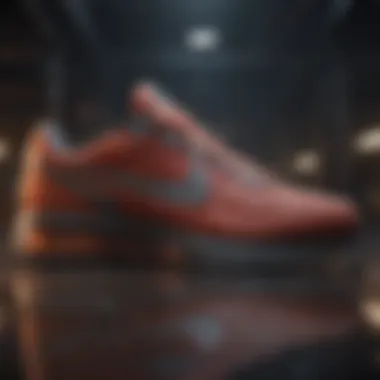The Nike Swoosh: Redefining Sportswear Culture


Intro
The Nike Swoosh is more than just a logo; it’s a representation of determination, aspiration, and an ever-evolving lifestyle. For thrill-seekers and extreme sports enthusiasts, this symbol has transcended its role as a mere brand marker and has become an integral part of their identity. This article charts the journey of the Swoosh from its inception to its current stature as a cultural icon, linking it to the way people connect not just with sports but with broader lifestyle choices.
In understanding its impact, we begin with the historical backdrop of Nike's rise to prominence. Founded by Phil Knight and Bill Bowerman in 1964, the company initially focused on running shoes. However, as the demand for athletic apparel surged, so did Nike’s ambitions. With the introduction of the Swoosh in 1971, the logo was designed to embody speed and movement—a fitting association for athletes who push their limits.
What’s more, the Swoosh has established itself within extreme sports communities, influencing not only athlete performance but also defining consumer behavior. In the following sections, we will explore various dimensions of this cultural phenomenon, examining how marketing strategies, ethical considerations, and technological innovations have shaped and shifted perceptions:
- The design philosophy behind the Swoosh
- How collaborations in extreme sports have influenced branding
- The effect of consumer behavior on the growth of Nike in the sportswear sector
- Insights into environmental and ethical concerns facing the industry today.
Get ready to dive deep as we untangle the complex relationship between the Swoosh and the sportswear culture that thrives around it.
Foreword to the Nike Swoosh
The Nike Swoosh stands as a beacon in the realm of sportswear, embodying more than just a logo. It serves as a cultural touchstone that represents athletic excellence, style, and a certain audacity that comes with pushing boundaries. This section aims to delve into the origins of the Swoosh as well as its evolution into a symbol of not only a brand but a broader lifestyle, especially for thrill-seekers and adventure lovers.
Origins of the Swoosh
The inception of the Nike Swoosh is a tale steeped in both creativity and tenacity. Created in 1971 by graphic design student Carolyn Davidson, this logo emerged during a time when sports branding was just getting on its feet. Davidson, who was paid a meager sum for her work, designed the Swoosh with the aim of capturing motion and speed, concepts inherently tied to athletic performance. The emblem's simplicity and flowing design hinted at movement, making it a fitting representation for a brand that would soon aim to revolutionize how athletes saw their gear.
Initially, the Swoosh was met with varied reception; some thought it looked like a tick or even a checkmark. Yet, over the years, it has evolved into an iconic representation of sport and athleticism, one that stands tall amidst competition. It wasn’t until the late 1980s that the Swoosh started gaining momentum as part of Nike’s marketing strategy. High-profile endorsements, notably with athletes like Michael Jordan and Serena Williams, helped catapult the Swoosh into pop culture as athletes began emerging not only as sports icons but as cultural figures.
The Swoosh as a Symbol
The Swoosh has transcended its original purpose and has developed into a multi-layered symbol, representing a spirit of rebellion and achievement. For many, wearing the Swoosh is akin to flaunting one’s dedication to sports, fitness, and a lifestyle laden with tenacity. The just do it mantra associated with Nike drives home the brand’s philosophy that champions action over inaction.
This logo also serves as a conduit for personal expression. With its omnipresence in every imaginable athletic venture, from skateboarding to running marathons, the Swoosh embodies more than the gear; it encapsulates the passion and commitment of those who wear it.
"The Nike Swoosh is more than just a logo; it's a representation of a mindset—one where every step taken is a step towards greatness."
As an every-day symbol, the Swoosh saturates various aspects of culture, from street fashion to extreme sports. This versatility undoubtedly places it above other logos in the sportswear industry, establishing not just Nike’s identity but also fostering a community among like-minded individuals who chase adventure and aspire for greatness.
In summary, the origins and symbolic significance of the Nike Swoosh reflect the deeper narratives of aspiration and identity that define the sportswear culture today. Its ability to resonate with diverse audiences while maintaining its distinct core speaks volumes about its impact and presence in the world of athletics and beyond.
Nike's Evolution in Sportswear
The story of Nike's evolution in sportswear isn't just a tale of growth; it’s a testament to how innovation, branding, and strategic partnerships can reshape an entire industry. Nike has become synonymous with sports culture, embodying the spirit of competition and the quest for excellence. Throughout this segment, we will explore critical aspects of this evolution—historical context, significant milestones, and the brand's far-reaching global influence.
Historical Context
Nike's inception in the early 1970s coincided with a societal shift towards fitness and athleticism. The world was witnessing a surge in running enthusiasts—a movement fueled by health consciousness and leisure. It was then that Phil Knight, a former middle-distance runner, and his coach Bill Bowerman saw an opportunity. They created a company that initially focused on selling imported running shoes from Japan. As trends in sportswear began to take shape, Nike quickly grabbed the proverbial bull by the horns. The early 1970s also saw the rise of jogging as a popular pastime in America. With it came an expanding market longing for quality footwear.
Nike entered the scene with a clear vision and a unique approach, mainly targeting not just elite athletes, but regular folks looking to lead healthier lives. This broad approach enabled Nike to cultivate a diverse customer base that extended far beyond the track.
Milestones in Brand Development
As Nike grew, it marked several significant milestones that helped solidify its position in sportswear. From introducing the revolutionary Waffle Sole in 1974 to the launch of the Air Jordan franchise in 1984, each step transformed the landscape.
- 1971: The birth of the Swoosh logo marked the beginning of Nike’s visual identity. This simple yet effective design became an emblem, connecting with consumers on levels that words cannot express.
- 1980s: The partnership with basketball icon Michael Jordan redefined marketing strategies. Nike successfully bridged the gap between sports and pop culture. Air Jordans became more than shoes; they became a cultural phenomenon, changing how sportswear was perceived globally.
- 1990s-2000s: As Nike ventured into the realm of sponsorships, it backed various athletes and teams across multiple sports. This expansive approach helped the brand to establish a strong connection with diverse consumer segments.
This quest for expansion let Nike experiment with marketing and innovative designs, consistently pushing boundaries and setting themselves apart from competitors.


Nike's Global Reach
Nike's evolution didn't remain confined to the borders of the United States. The brand’s global reach is a driving force in its success. By opening stores and establishing partnerships worldwide, Nike transformed into a global icon.
- Emerging Markets: Nike targeted markets in Asia, Europe, and Latin America, treating them not just as sales regions but as crucial stakeholders in the brand’s narrative.
- Cultural Adaptation: The brand's ability to adapt to local cultures while maintaining a unified global identity has been vital. Nike understands that effective marketing isn't a one-size-fits-all matter. The Swoosh resonates universally while allowing for localized messages.
- Collaboration with Influencers: Collaborations with renowned figures—be it athletes like Serena Williams or celebrities such as Travis Scott—amplified their reach, ensuring that Nike was at the forefront of cultural discussions.
In summary, Nike’s evolution in sportswear has been marked by a keen understanding of the market, innovative design practices, and effective storytelling. This intricate tapestry of history, milestones, and global influence is what puts Nike on the pedestal of sportswear culture. Through every twist and turn, the brand has systematically cultivated an identity that not only transcended sports, but lifestyle choices as well.
Design Philosophy Behind the Swoosh
The Nike Swoosh isn't just a mere logo; it's a profound representation of what the brand stands for. The design philosophy behind it speaks volumes about the importance of minimalism in branding, adhering to the essence of the brand while also tapping into the psychological aspects of consumer interaction. Understanding this philosophy offers insight into Nike's success, particularly in its appeal to thrill-seekers, extreme sports enthusiasts, and adventure lovers.
Minimalism in Branding
At its core, Nike’s Swoosh embodies the principle of less is more. The design lacks any unnecessary elements, allowing it to project a sense of speed, agility, and motion. This simplicity resonates deeply with consumers. By stripping away the superfluous, the Swoosh stands strong and unapologetic, making it instantly recognizable across the globe.
- Immediate Recognition: In a crowded marketplace filled with flashy logos, the Swoosh is a breath of fresh air. It’s concise but powerful.
- Timelessness: A minimalistic design transcends trends; it remains relevant regardless of the changing fashion tides.
- Focus on Performance: The Swoosh emphasizes a focus on performance rather than just aesthetics. This speaks directly to athletes who prioritize functionality.
Many brands often complicate their logos with intricate designs, hoping to convey luxury or sophistication. However, Nike chose the road less traveled. Instead of a complicated visual identity, they relied on a simple mark that demonstrates action and dynamism. This straightforward design strategy resonates particularly in extreme sports where speed, agility, and courage are paramount. The Swoosh directly connects with the adrenaline-fueled lifestyle of its wearers.
Psychology of the Swoosh
The psychological impact of the Nike Swoosh extends beyond its aesthetic appeal. It creates an emotional connection with its consumers, linking the brand to not just products, but an entire lifestyle and mentality. Studies in branding psychology show that simple logos can create stronger associations and foster loyalty. Here’s how the Swoosh accomplishes this:
- Symbol of Achievement: The Swoosh represents triumph and success, capturing the human desire for accomplishment. It's often viewed as a badge of honor among athletes and athletic wearers.
- Identity Creation: The logo allows enthusiasts and athletes alike to identify with a larger community. When you wear the Swoosh, it’s not just about the product; it’s about belonging to a culture that values hard work and determination.
- Inspiring Motivation: The simplicity of the design motivates people to push past their limits. Each glance at the Swoosh encourages individuals to embody the phrase "Just Do It", serving as a subtle nudge towards their goals.
"A powerful logo does not merely sell; it influences emotions and aspirations."
The Swoosh’s ability to evoke feelings of empowerment and determination showcases its strong psychological grip on consumers. The connection consumers have with this simple yet potent symbol illustrates the wealth of meaning packed into a streamlined design.
Nike in Extreme Sports
The landscape of extreme sports has seen considerable transformation over the years. This shift has not only defined the sports themselves but also influenced the brands that choose to associate with this adrenaline-fueled culture. Nike, with its instantly recognizable Swoosh, takes a prominent place in this realm. Their involvement goes beyond sponsorship; it's about a commitment to embodying the spirit of extreme sports, each product telling a story that resonates with thrill-seekers.
Engagement with the Extreme Sports Community
The connection between Nike and the extreme sports community is palpable. Nike taps into vibrant cultures like skateboarding, snowboarding, and BMX biking by engaging actively with athletes, artists, and enthusiasts. This engagement is not merely a marketing ploy; it's about understanding and becoming a part of the community.
A crucial element in this dynamic is Nike's emphasis on collaboration. By working closely with professional athletes, they not only gain insight into what drives performance but also infuse creativity into their designs. For instance, pro-skater Paul Rodriguez has helped shape the Nike SB line, which reflects the style and functionality demanded by skateboarders. And the influence goes both ways; the raw, counter-cultural vibes from these sports seep back into Nike's broader brand ethos, making it more relatable and authentic.
Another factor is Nike’s presence in extreme sports events. Through festival sponsorships and athlete showcases, they maintain a constant buzz around their products, gaining visibility. Events like the X Games or the Dew Tour serve as stages for Nike athletes to shine, showcasing their gear in action. The excitement generated from these events translates into conversations, social media buzz, and ultimately, a stronger connection with the audience.
Sponsorships and Collaborations
Understanding the importance of sponsorships and collaborations is key to unraveling Nike's strategy in the world of extreme sports. Nike’s decisive moves to partner with prominent athletes not only amplify their brand’s visibility but also cement their place within these niche markets. For example, Nike’s collaboration with the legendary skateboarder Eric Koston led to the creation of signature shoes that seamlessly blend performance with style, catering to both serious athletes and casual skaters alike.
Moreover, Nike consistently looks outside traditional boundaries for collaborations. They partner with up-and-coming brands and local artists to create limited-edition products that reflect the spirit of the communities they serve. This grassroots approach fosters loyalty and adds a unique twist to Nike’s offerings. In many cases, these limited releases spark a sense of urgency and exclusivity, considering how quickly they can fly off the shelves.
"Nike’s ability to understand the pulse of the extreme sports culture is what sets it apart. It’s not just about making gear; it’s about making a lifestyle statement."
By leveraging both sponsorships and community engagement, Nike ensures that it stays not only a leader in sportswear but also a vital part of the extreme sports narrative. The emotional attachment that extreme sports enthusiasts feel toward these partnerships often transcends fanaticism; it creates a movement, with Nike at the forefront, steering the conversation and innovation within the sportswear culture.
In this context, Nike doesn’t just push products; they push the boundaries of what it means to be a brand enveloped in the high-octane world of extreme sports.


Consumer Behavior and the Swoosh
In examining the Nike Swoosh, it's essential to highlight its profound influence on consumer behavior. The Swoosh is not merely a logo; it stands as a cultural icon that shapes identities and lifestyles of many, particularly within the sportswear culture. The interplay between consumer emotions and the symbolism of the Swoosh creates a fertile ground for brands to grow and cultivate loyalty. This section dives into how the Swoosh fosters brand loyalty, shapes identity, and influences trends.
Brand Loyalty and Identity
Brand loyalty is a powerful engine that drives repeat purchases and forms lasting connections between consumers and brands. For many, wearing the Nike Swoosh is more than a choice; it reflects an ethos of performance, determination, and achievement. The identity formed around the brand is significant. The Swoosh signifies not just athleticism but also a lifestyle choice, blurring the lines between the realms of sport and everyday life.
- Identity Connection: Consumers often associate the Swoosh with the narratives of famous athletes who have donned the brand. When you see LeBron James or Serena Williams, the Swoosh acts as a bridge, linking personal aspirations to these athletic icons. This connection runs deep; when a consumer wears Nike gear, they’re not just making a fashion statement but aligning themselves with the achievements and values of these figures.
- Community and Belonging: The Swoosh fosters a sense of community among its wearers. Group events, such as marathons or skateboarding competitions, see vast crowds sporting this emblem. This collective experience enhances consumer loyalty as individuals feel part of something bigger than themselves. It goes beyond individual purchases into the realm of shared values and experiences.
- Emotional Resonance: Nike has masterfully crafted narratives that appeal to consumer emotions. Their campaigns often focus on empowerment, resilience, and victory. When consumers engage with the brand, they often envision their future selves, pushing their limits and achieving goals. This creates an emotional tie — consumers are not just buyers; they are enthusiasts and advocates, ready to promote the Swoosh in their daily lives.
The Influence on Trends
Nike is often at the forefront of shaping trends in sportswear and beyond. The Swoosh acts as a beacon, guiding modern fashion choices and lifestyle habits.
- Streetwear Crossovers: The crossover between high fashion and streetwear illustrates the Swoosh's wide-reaching influence. Designers from various backgrounds have incorporated Nike into their collections, effectively blurring the lines between athletic wear and everyday ensembles. This trend toward athleisure was fueled by a renewed focus on comfort and functionality that resonates well with today's consumer base.
- Sustainable Fashion: Consumers today are increasingly conscious about their purchases. The Nike Swoosh has aligned with the growing trend towards sustainability, appealing to eco-aware shoppers. By introducing lines like Nike's Move to Zero initiative, the Swoosh has become synonymous with environmentally friendly practices. The modern consumer values products that reflect their ecological concerns, ensuring that the Swoosh remains relevant in changing times.
- Influencer Culture: Social media has revolutionized consumer behavior, and Nike's sponsorships and endorsements of influencers amplify this effect. The Swoosh, prominently displayed on social platforms, influences purchasing decisions among new demographics like Gen Z and Millennials. As these platforms continue to grow, so too does Nike’s outreach.
"In a world where consumers are continuously bombarded with options, the Nike Swoosh stands tall, a silent influencer that shapes the very fabric of sportswear culture."
In summary, the Nike Swoosh plays a pivotal role in shaping not just consumer choices, but also community, identity, and trends within sportswear culture. Understanding this impact opens up new avenues for anticipating future developments in the industry.
Impact on Athletic Performance
The intersection of branding and athletic performance is a fascinating territory often glossed over in casual discussions about sportswear. Yet, the Nike Swoosh plays a pivotal role here, transcending mere aesthetics to fundamentally influence how athletes perceive their capabilities. The importance of examining the Nike Swoosh in this light lies in its capacity to motivate, inspire, and enhance physical performance, serving as a badge of honor for many wearing it.
Performance-Enhancing Gear
Nike has been at the forefront of any innovation in sports equipment and apparel. The company has introduced numerous performance-enhancing products designed with cutting-edge technology. Think about the Vapor Max shoes or the AlphaFly running shoes. These aren’t just footwear; they're meticulously engineered to boost an athlete's performance metrics. With features like lightweight materials, specialized cushioning, and advanced traction systems, they help reduce fatigue, improve agility, and provide better support where it's needed the most.
- Weight: Lighter shoes decrease overall exertion.
- Cushioning: Superior impact absorption protects joints.
- Traction: Enhanced grip allows for better control during extreme maneuvers.
While some might say it’s all a marketing gimmick, there’s tangible evidence suggesting that a well-constructed shoe can lead to improved times and performance levels. Athletes often report feeling a psychologically beneficial boost, which leads us to the next crucial piece of the puzzle.
Psychological Effects of Branding
The Swoosh isn’t just a symbol; it embodies a mindset. The psychological effects of branding in sportswear culture can’t be understated. Wearing items that carry the infamous logo can instill a sense of confidence in athletes. When wearing Nike gear, many believe they’re imbued with the spirit of competitive greatness associated with top-tier athletes.
"It’s like wearing the armor of champions. When I lace up my Nikes, I feel ready to conquer anything on my path.” — An avid runner
Additionally, brand loyalty fortified by effective marketing strategies fosters an emotional bond with consumers. Athletes often associate Nike with accomplishment, which in turn impacts their performance. The mental boost provided by comfortable, stylish gear can drive individuals to push beyond their limits.
Key Impacts
- Enhanced Confidence: The Swoosh makes athletes feel part of an exclusive club.
- Focus: Branding can help frame the mindset; wearing Nike may encourage commitment.
- Identity: Extreme sports enthusiasts often express their identity through these brands, impacting how they perform.
ultimate performance.
Ethical Considerations in Sportswear Manufacturing
As the Nike Swoosh continues to be a revered icon in sportswear, it's essential to pick apart ethical considerations in sportswear manufacturing. Social conscience has gained momentum, as consumers increasingly expect brands to operate responsibly and transparently. The ethical dimensions touch various aspects—from labor practices in overseas factories to the environmental consequences of manufacturing. A careful examination of these factors not only strengthens a brand's identity but can also bolster consumer loyalty and trust.
Environmental Impact of Production


The environmental impact of production in the sportswear industry is significant. Nike, with its vast global footprint, has faced scrutiny over the years regarding its manufacturing processes. The lifecycle of a sneaker—from raw material acquisition to final disposal—can contribute markedly to waste and pollution. Common practices in manufacturing often include chemical treatments and disposal methods that may harm local ecosystems.
- Resource Depletion: Manufacturing requires large quantities of water, energy, and raw materials. This increases pressure on natural resources and can lead to shortages.
- Chemical Waste: The use of solvents and toxic chemicals prompts concern about air, water, and soil pollution, with negative consequences extending to communities surrounding production facilities.
Efforts are being made to mitigate these issues, as more brands come to grips with their environmental responsibilities. Sustainable materials like recycled polyester and organic cotton are becoming more mainstream in production processes.
“The true cost of a product is measured not only in dollars but also in environmental impact and labor ethics.”
Sustainability Initiatives by Nike
Nike is not simply sitting on its laurels when it comes to its impact on the environment. The company has proactively sought ways to implement sustainability initiatives that address criticisms and pave the way for a greener future. Some of the initiatives include:
- Move to Zero: This initiative aims to drastically reduce Nike's carbon footprint and waste production. The goal is to create a zero-carbon and zero-waste future.
- Circular Economy: Nike has introduced programs that encourage recycling and reuse. Their Reuse-A-Shoe program allows old footwear to be transformed into surfaces for playgrounds and sports courts.
- Innovative Materials: Nike has been investing in research to develop new materials that minimize environmental impact, such as Flyleather, made with at least 50% recycled natural leather fiber.
By fostering an environmentally-conscious ethos, Nike not only stands to improve its brand image but also resonates with today’s consumer base that increasingly values sustainability. The narrative surrounding the brand focuses more on innovation coupled with responsibility, which attracts both consumers who care about extreme sports and those who prioritize ethical consumption.
Future of the Nike Swoosh in Sportswear
The Nike Swoosh, an iconic symbol seen everywhere, isn’t just a logo; it represents what’s next in sports apparel. As we glance into the future, understanding its trajectory helps unravel how it shapes sportswear culture. The Swoosh has continually been at the forefront, adapting to changing times, trends, and technologies. Acknowledging the significance of this evolution ensures we comprehend not only its historical influence but also its potential impact moving forward.
Emerging Trends in Sportswear Fashion
Fashion within the sportswear realm is often cyclical. However, the Nike Swoosh has been a game changer. Currently, several trends are emerging that indicate where the Swoosh may lead.
- Sustainability: Consumers are more conscientious now than ever about the environment. Expect Nike to increasingly lean on sustainable materials in their production. This trend encourages better practices in sourcing and manufacturing.
- Athleisure Dominance: Blurring the lines between gym wear and casual chic is gaining momentum. Nike's ability to create pieces that serve both functions will keep it at the forefront.
- Inclusivity in Sizes and Designs: The push for representing diverse body types will likely see Nike expanding its range, allowing more individuals to feel part of the brand's narrative.
These trends not only reflect societal shifts but also present opportunities for Nike to redefine itself continuously. The Swoosh’s adaptability is key, tying its meaning even more deeply into the fabric of fashion culture.
Technology and Innovation in Design
Nike’s commitment to innovation is synonymous with its brand identity. As we plunge deeper into the 21st century, tech advancements are set to play a pivotal role in shaping the designs encapsulated by the Swoosh.
- Smart Fabrics: Innovations are not just limiting themselves to appearance. Imagine fabric that adapts to temperature or moisture. This can enhance performance for athletes, providing them a competitive edge.
- Customizable Gear with App Integration: As technology becomes more embedded in everyday life, the ability to customize performance gear via apps is likely to become a reality. Users could design their own Swoosh-branded products to fit personal preferences.
- Augmented Reality Experiences: Interactions with the brand may evolve through augmented reality. Picture a sneaker that, when scanned, tells you its entire story—where it was made, the technologies included, and how to care for it.
The interplay of technology and design ensures that the Swoosh remains at the cutting edge. As it evolves in response to technological advances, it keeps its relevance and appeal alive.
"The Swoosh is not just a mark; it’s a commitment to progress and innovation. Because with every step Nike takes, it becomes a part of our lives—fashion, performance, and identity intertwined."
Understanding what's next for the Nike Swoosh in the realm of sportswear allows us to appreciate its extensive impact on culture, consumer behavior, and the athletic community. As we become aware of these emerging trends and innovative technologies, we can anticipate not just how the Swoosh evolves but also how it continues to inspire a generation of thrill-seekers and adventure lovers.
Epilogue
The significance of the Nike Swoosh extends far beyond just being an emblem on a sneaker. This conclusion delves into the essence of what the Swoosh represents in the broader context of sportswear culture and its lasting impact on individuals and communities alike. The Swoosh has been a competent player in the game, embodying themes of achievement and identity.
The Enduring Legacy of the Swoosh
Over the years, the Swoosh has transcended its original purpose. Originally a mere logo, it has become a cultural icon, serving not just athletes, but individuals seeking motivation and inspiration. The Swoosh encapsulates a spirit of determination and the drive to push personal limits. This legacy is not only felt in sports but also in everyday life. People wear it as a badge of pride, signaling not only their athletic aspirations but also their lifestyle choices.
The mystique surrounding the Swoosh contributes to its persistence in the industry. It has adapted over generations, maintaining relevance through innovations in design and thoughtful collaborations. This adaptability is evident in the way Nike engages with various communities, from established sports to emerging street culture.
"A logo is only as good as its story; the Swoosh's narrative is about empowerment and relentless pursuit of excellence."
Reflection on the Future of Sportswear
What lies ahead for the Nike Swoosh? As the landscape of sportswear evolves, driven largely by advancements in technology and changing consumer preferences, the Swoosh’s ability to remain relevant hinges on its willingness to innovate. With a spotlight now shining on sustainable practices and ethical production, Nike's future commitments will resonate deeply with a more conscious consumer base. The rising trend of athletes endorsing mental health and well-being also intertwines with the Swoosh's legacy.
Moreover, as extreme sports gain traction, the Swoosh is poised to solidify its place in an ever-expanding arena. Collaborations with innovators in sports technology could yield cutting-edge gear that improves performance while maintaining the aesthetic appeal that has long been attributed to Nike branding.
The Swoosh stands at a crossroad, where past legacy meets future commitment. Navigating this path will refine not only the brand's image but also its role in shaping sportswear culture. The challenge for Nike now, beyond just selling products, will be to foster deeper connections with the global community, ensuring that the Swoosh continues to be not merely a logo, but a representation of aspiration and belonging in a rapidly changing world.







